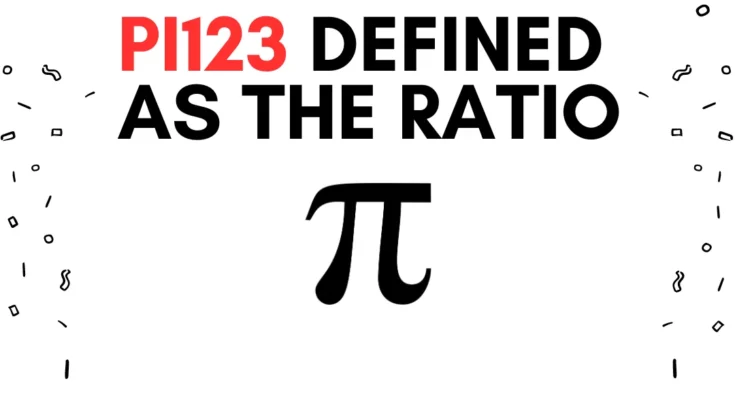Pi123 is a unique sequence of numbers that has intrigued mathematicians and curious minds for centuries. Consisting of the numbers 3.14159 26535 89793 23846 26433 83279 50288 41971 69399 37510. Pi (symbolized by the Greek letter “π”) is an irrational and transcendental number that continues infinitely without repetition or pattern. The first few digits “3.14” are the most widely recognized, but pi contains an infinite number of digits that extend forever after the decimal point.
In this article, we will explore what pi (π) is, the significance of the sequence “123” in pi, how pi is used. And why this infinite number continues to fascinate people across all fields and cultures.
What is Pi123?
Pi (π) is defined as the ratio of a circle’s circumference to its diameter. No matter the size of the circle, this ratio always comes out to approximately 3.14. Here’s a quick explanation of pi:
– Circumference is the distance around the circle.
– Diameter is the distance across the circle passing through its center.
– Divide the circumference by the diameter and you get pi.
For example, if a circle has a diameter of 2 inches, its circumference will be 2 * π inches. So Pi relates a circle’s diameter and circumference through multiplication and division.
Due to pi’s infinite & patternless nature, it’s usually rounded to 3.14 or approximated with just a few decimal places for practical use in math & science formulas. But its theoretical value extends forever without repeating or terminating.

Significance of “123” in Pi
The sequence “123” appears extremely early in pi, specifically after only four decimal places. The full sequence of numbers is “3.1416” with the “123” appearing immediately after the common approximation of 3.14.
The fact that pi contains this simple ascending sequence so close to the start is an intriguing coincidence that has no special mathematical significance. However, the early appearance of “123” has made some view it as a hint at deeper meanings hidden within pi’s endless randomness.
Others use the “123” sequence as a handy reference point when trying to memorize more digits past 3.14. No matter how it’s interpreted, these three ascending numbers remain one of the earliest distinct patterns visible in pi’s digits before chaos takes over again shortly thereafter.
How Pi is Used
Pi’s infinite nature allows it to have endless applications in mathematics and science. Here are some of the most common uses of pi:
Calculating Circles – Pi is most frequently used for measuring circles & spherical objects in geometry. Circumference, area, volume and more are all derived with formulas involving pi.
Trigonometry – Pi plays an integral role in almost all trigonometric functions used for calculations involving waves, optics and more.
Physics & Engineering – Modeling intricate natural phenomena in fields like physics, mechanics and quantum dynamics requires pi for calculations.
Random Number Generation – Pi’s patternless digits have applications in generating random sequences for statistics, cryptography and Monte Carlo simulations.
From ancient construction by societies like the Egyptians and Babylonians to advanced physics theories explaining the Universe itself, pi underlies it all. New discoveries keep unveiling pi’s presence across math and nature.
Why the Fascination With Pi Continues
There are likely a few key reasons why pi and its endless sequence of random digits continues to fascinate mathematicians and non-mathematicians alike:
Universality – Pi links so many mathematical formulas & natural phenomena across disciplines. Cementing its role as a fundamental base of calculations in science and beyond.
Curiosity Over Patterns – Many wonder if there is an underlying order or message hidden somewhere within pi’s randomness, sparking new research into the numbers on a recreational level.
Simplicity of Origin – That such an endless string of complexity arises simply from dividing a circle’s circumference by its diameter is elegant and remarkable.
Computation as Challenge – There is also an element of competition and collaborative spirit driving various enthusiasts and supercomputers to calculate ever more digits of pi simply for achievement’s sake.
Pi has had cultural appeal for various reasons too, as explored in art, poetry, music and more over history. In the end pi’s ubiquity and air of mystery gives it a unique standout quality separating it from other mathematical constants.
Conclusion
The infinite number pi has been fascinating mankind for millennia. Within its digits is an ascending sequence “Pi123” at the very start after 3.14. Though this has no mathematical significance, it adds to pi’s mystery and appeal. As an irrational number fundamental to circular geometry and beyond. Picontinues finding usefulness across mathematics and nature – likely ensuring mathematicians and casual admirers will continue exploring it forevermore.
Also Read: Next Exam Tak: How to Prepare for the GCSE and A-level Exams 2024



